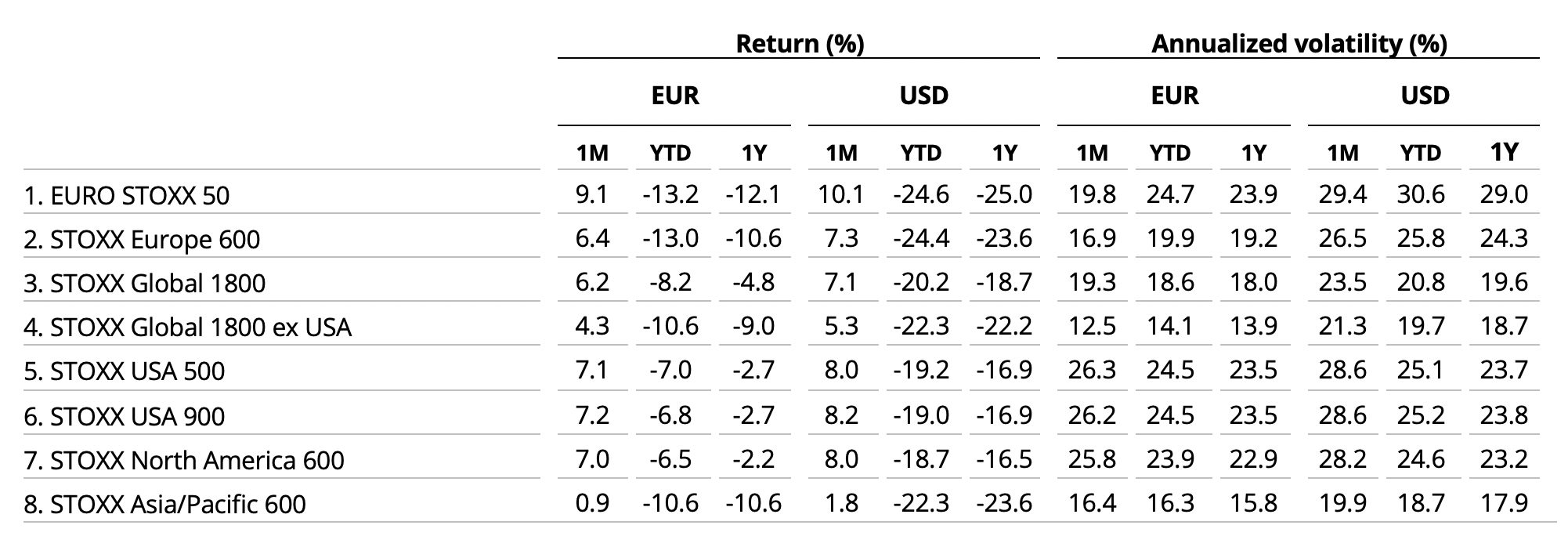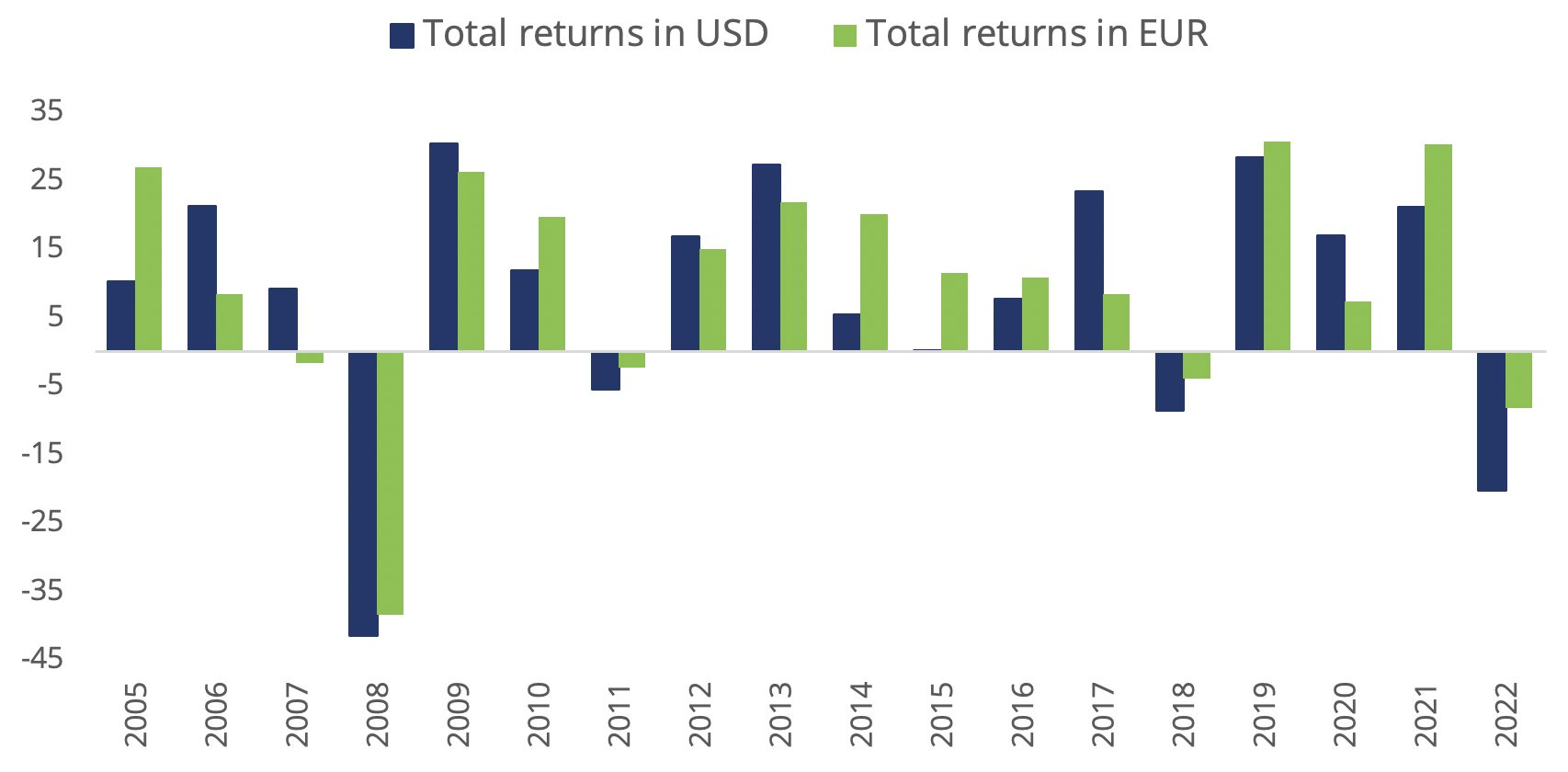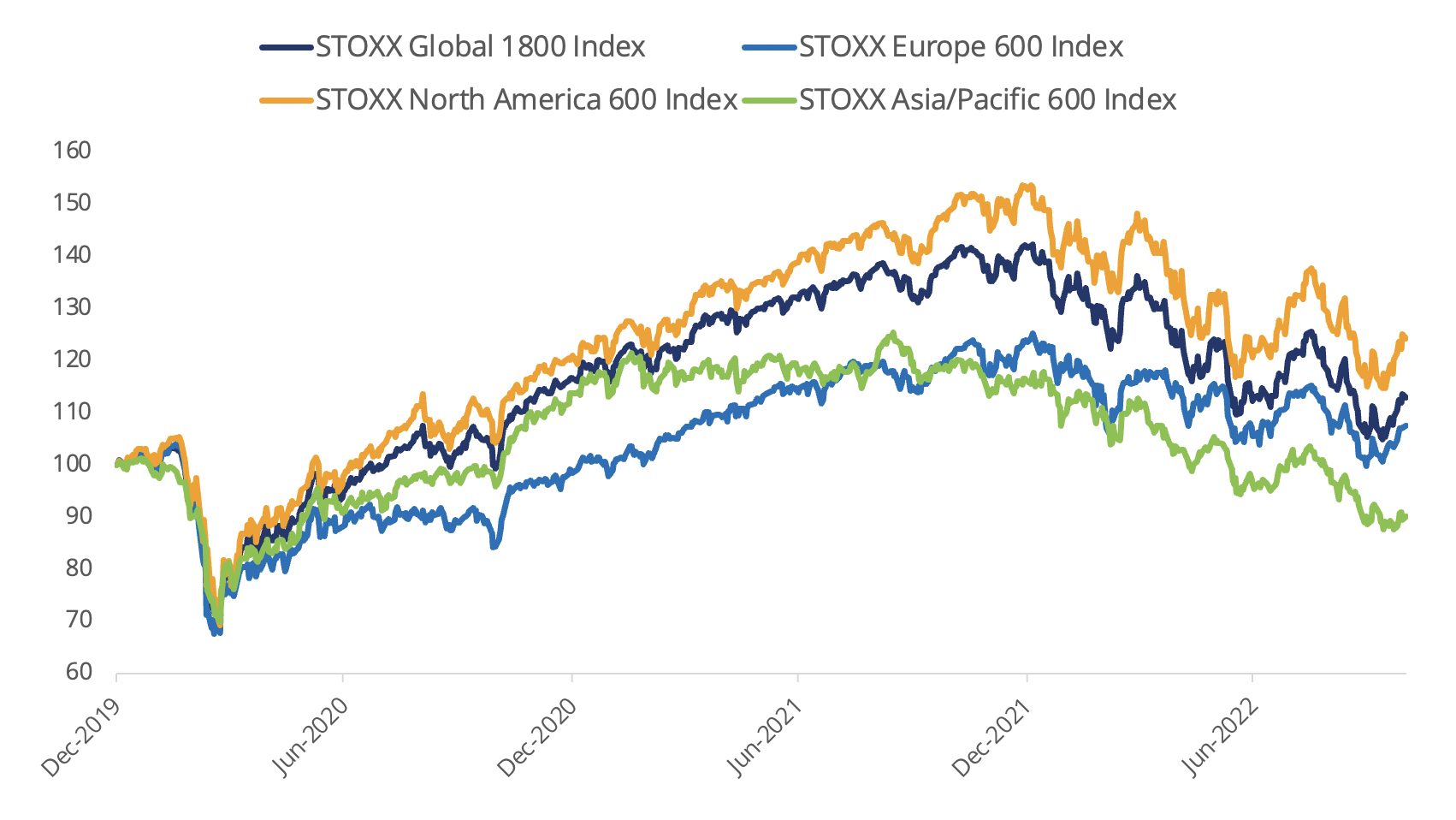The STOXX® Global 1800 index rebounded from a two-year low last month on investors’ expectations that the Federal Reserve would soon slow down the pace of interest-rate hikes.
The global benchmark added 7.1% in October when measured in dollars and including dividends1. It rose 6.2% in euros after the common currency strengthened 0.9% against the greenback. The benchmark has still fallen 20.2% in 2022, poised for its worst year since the Global Financial Crisis in 2008.
The STOXX® North America 600 gained 8% in dollars in October, as did the STOXX® USA 5002. The pan-European STOXX® Europe 600 climbed 6.4% in euros and the Eurozone’s EURO STOXX 50® increased 9.1%. The STOXX® Asia/Pacific 600 rose 1.8% in dollars, held back by stocks in Japan and Hong Kong.
Figure 1: Benchmark indices’ October risk and return characteristics

Germany’s DAX® gained 9.4% in the month. MDAX®, which gauges the performance of German mid-caps, rose 5.8%.
Monetary policy
While most economists rightly forecast the Fed’s fourth consecutive hike of 75 basis points on Nov. 2, speculation rose during October that the central bank could indicate it would slow the pace of monetary tightening. Fed Chair Jay Powell has overseen a sharp increase in the cost of borrowing to contain inflation, curbing spending and economic growth.
| For a complete review of all indices’ performance last month, visit our October index newsletter. |
Figure 2: Annual % returns for STOXX Global 1800 index

Figure 3: Returns since January 1, 2020

Volatility drops
The EURO STOXX 50® Volatility (VSTOXX®), which tracks EURO STOXX 50 options prices, slipped to 24.8 at the end of last month from 30.7 in September. A higher VSTOXX reading suggests investors are paying up for puts that offer insurance against stock price drops. The VDAX-New®, which measures volatility in German equities, fell to 25.2 from 30.7 in September.
Singapore and Hong Kong buck trend
All but two of 25 developed markets tracked by STOXX advanced in October when measured in dollars, with Singapore and Hong Kong bucking the trend. The STOXX® Developed Markets 2400 index added 7.3% in dollars and 6.4% in euros.
Fifteen of 20 national developing markets rose in the month on a dollar basis. The STOXX® Emerging Markets 1500 index gained 0.8% in the US currency, as a drop in Chinese shares weighed on the benchmark, and was little changed in euros.
All but one of 20 Supersectors in the STOXX Global 1800 had a positive return in the month. The STOXX® Global 1800 Automobiles & Parts was the exception after dropping 2.4%.
Factor investing
Momentum was the best-performing style in the month, according to the STOXX Factor indices. The STOXX® Global 1800 Ax Momentum rose 9.3%.
Figure 4: STOXX Factor (Global) indices’ October risk and return characteristics

Climate benchmarks
Among climate benchmarks, the STOXX® Global 1800 Paris-Aligned Benchmark (PAB) and the STOXX® Global 1800 Climate Transition Benchmark (CTB) added 5.9% and 6.3%, respectively. The PAB and CTB indices follow the requirements outlined by the European Commission’s climate benchmarks regulation.
The STOXX® Willis Towers Watson World Climate Transition Index advanced 6.1%. The STOXX Willis Towers Watson Climate Transition Indices (CTIs) employ a unique Climate Transition Value at Risk (CTVaR) methodology that quantifies the anticipated impact of an economic transition on equity valuations. The CTIs look beyond carbon emissions and make a forward-looking, bottom-up evaluation of asset repricing risks in a decarbonization pathway.
Among the STOXX Low Carbon indices, the EURO STOXX 50® Low Carbon (8.6%)3 underperformed the EURO STOXX 50 by 50 basis points in October. Elsewhere, the STOXX® Global Climate Change Leaders (6.6%), which selects corporate leaders that are publicly committed to reducing their carbon footprint, underperformed the STOXX Global 1800 index by 51 basis points.
ESG-X and ESG indices
The STOXX® Global 1800 ESG-X index added 7% in the month. The STOXX® ESG-X indices are versions of traditional, market-capitalization-weighted benchmarks that observe standard responsible exclusions of leading asset owners.
Within indices that combine exclusions and ESG best-in-class integration, the EURO STOXX 50® ESG index rose 8.5%. Germany’s DAX® 50 ESG index (8.7%), which excludes companies involved in controversial activities and integrates ESG scoring into stock selection, underperformed the benchmark DAX.
Sustainability indices
Among other STOXX sustainability families, the STOXX® Global 1800 ESG Broad Market index rose 6.7% in the month. The STOXX ESG Broad Market indices apply a set of compliance, product involvement and ESG performance exclusionary screens on a starting benchmark universe until only the 80% top ESG-rated constituents remain.
The STOXX® Global 1800 ESG Target climbed 7.8%, the EURO STOXX® ESG Target rose 7.6% and the DAX® ESG Target gained 8.4%. The STOXX and DAX ESG Target indices seek to significantly improve the benchmark portfolio’s ESG profile while mirroring its returns as closely as possible. Through a series of constraints, the indices implement an optimization process to maximize the overall ESG score of the portfolio while limiting the tracking error to the benchmark.
The STOXX® Global 1800 SRI added 8.4%. The STOXX SRI indices apply a rigorous set of carbon emission intensity, compliance and involvement screens, and track the best ESG performers in each industry group within a selection of STOXX benchmarks.
Finally, the DAX® ESG Screened rose 8.7%. The index reflects the composition of the DAX benchmark minus companies that fail to pass norms-based and controversial weapons screenings, meet minimum ESG ratings or are involved in certain business activities considered undesirable from a responsible investing perspective.
Thematic indices
It was a difficult month for the revenue-based STOXX® Thematic indices, with all but two of 24 indices underperforming the benchmark STOXX Global 1800. The iSTOXX® Developed Markets B.R.AI.N., comprised of companies exposed to biotechnology (B), robotics (R), artificial intelligence (AI) and nanotechnology (N), led gains with a 9.6% return.
Among the STOXX artificial-intelligence-driven thematic indices, the STOXX® AI Global Artificial Intelligence index (7.2%) and its ADTV5 version (7.6%) outperformed the STOXX Global 1800, as did the iSTOXX® Yewno Developed Markets Blockchain index (10.4%).
Dividend strategies
Some dividend strategies struggled on a relative basis last month. The STOXX® Global Maximum Dividend 40 (7.2%) selects only the highest-dividend-yielding stocks. The STOXX® Global Select Dividend 100 (4.1%) tracks companies with sizeable dividends but also applies a quality filter such as a history of stable payments.
Minimum variance
There were poor relative performances from Minimum variance strategies last month. The STOXX® Global 1800 Minimum Variance added 4.1%. The STOXX® Global 1800 Minimum Variance Unconstrained rose only 0.2%, posting its widest monthly underperformance to the benchmark in 11 years.
The STOXX Minimum Variance Indices come in two versions. A constrained version has similar exposure to its market-capitalization-weighted benchmark but with lower risk. The unconstrained version, on the other hand, has more freedom to fulfill its minimum variance mandate within the same universe of stocks.
1 All results are total returns before taxes unless specified.
2 Throughout the article, all European indices are quoted in euros, while global, North America, US, Japan and Asia/Pacific indices are in dollars.
3 Figures in parentheses show last month’s gross returns.
